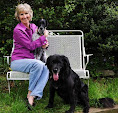Wow! I have to admit I didn't see that coming.
Do my dogs enjoy being dressed up? Not necessarily, although one female, Samba, seemed completely comfortable in whatever accessory I put on her head, around her neck, or over her back. And they all definitively enjoy the treats they get as part of every photo session.
Do my dogs mind being dressed up? They don't seem to...as long as I don't make them wear anything out of the ordinary for any length of time. Again, however, it depends on the dog. Ceiligh, my 32-pound dalmation/JRT/Labrador mix will prance around in a velvet red-and-white dress long after her photo has been snapped. And, as I mentioned above, the treats are always a big hit.
Do my dogs trust me not to do anything that would cause them pain or discomfort? Yes.
Are my dogs in any way damaged, physically or psychologically, by the experience of being dressed up for photographs? No.
After undergoing this internal assessment, I continue to believe that there's nothing inherently wrong with photographing animals in costumes. Now, personally, I have to admit that I'm not "into" dressing my dogs up on a regular basis. But I don't believe, either, that everyone who dresses their dogs in clothing considers their dogs as accessories. As one friend pointed out to me, her Chinese hairless cresteds would be miserably cold in the winter without coats.
But I digress.
When it comes to photographing shelter animals, I have one or more--positive--goals in mind: capture people's attention, make them aware of the organization's existence (and/or particular adoption or fundraising events), and increase the animals' chances of getting adopted. Let's face it, when it comes to animals, a picture really is worth a thousand words. Many people come to a shelter specifically to see a particular dog or cat because there was something about the animal's photo on Petfinder.com or the shelter's website that "called" to them. Costumes, accessories, and props can add to the attraction, making a viewer pay more attention to the photo; they also can make intimidating- or less-attractive-looking animals appear cuter, more appealing...and more "adoptable."
Because I care deeply about our shelter residents, I go out of my way to make the process of photographing them as pleasant as possible...whether or not costumes or props are involved. I spend a lot of time getting to know the "models"...not just because it facilitates my work but because I like spending time with them. In fact, I hang out with dogs in their dens on an almost daily basis, giving them treats and scratching their tummies, even if I have no particular intentions of photographing them.
When I do photograph the animals, dogs in particular, I take their background, temperament, and comfort level into consideration. With timid or frightened dogs, like puppy mill survivors, for example, I never use a flash because it scares them...which is the last thing their fragile psyches need. I also limit the length of the sessions and take as few shots as I need to get something usable because a camera lens can look to some dogs like the giant eye of a potential predator, which can be pretty scary. Basically, I tailor each photo shoot to the animal involved.
And when it comes to photographing animals in costumes, I'd like to point out that I--and the organization I work for--are far from alone. The homepage of the ASPCA currently includes a photo of a dog in antlers. The American Humane Association is offering a variety of holiday cards featuring puppies in Santa Claus hats for sale. The Houston SPCA, of "Animal Cops" fame, is selling antlers and Christmas ruffs for dogs on their website. And that's just the tip of the proverbial iceberg. A quick glance at the facebook postings of shelters and rescue organizations throughout the DC-area, and across the country, reveals photos of dogs of all sizes, shapes, ages, and breeds decked out in holiday dress. I readily admit to sharing many of them (they were too cute not to)...and wish I could take photographic credit for them.
Here's hoping these animals, and all the rest sharing shelter space with them, find homes soon!
And best wishes for a joyous holiday season from our home to yours.
























































